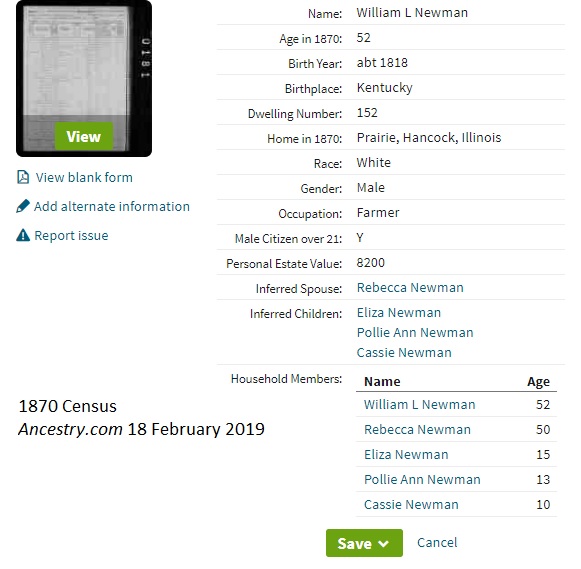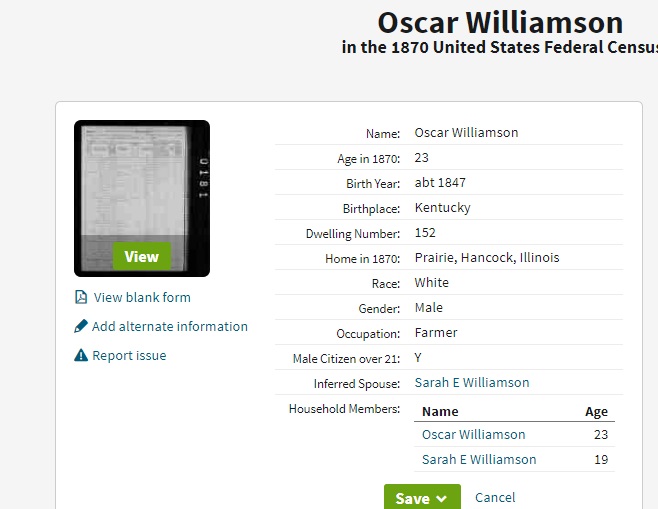According to Ancestry.com‘s 1870 census “index entry” for William L. Newman in Prairie Township, Hancock County, Illinois, there are only five individuals in his household–all of them named Newman.

Yet when one looks at the actual enumeration for William, it’s clear there are two others in the household: Oscar Williamson and Sarah E. Williamson.
The five Newmans and the two Williamsons are clearly in dwelling 152 household 148 in Prairie Township.

The Williamsons have apparently been put in a “separate” entry.

Why?
One should always read the actual image–we’ve made that point often enough that hopefully readers are aware of it. But it’s frustrating for Ancestry.com to “separate” out a household into two when clearly on the census it is one.

10 Responses
ancestry does so many stupid things it’s hard to keep track.
This happened in my research, too. My Great grandfathers parents died after the 1860 census. He was living with one married sister & his younger brother with another. If you didn’t open the record, you would never put two & two together and figure it out. It was as if the two boys disappeared until you took a closer look. This was in Mississippi. As if these young men would have been living by themselves?
This is clearly an indexing error. I have seen many households with multiple surnames that were indexed properly. Is it possible to make the correction and add these two individuals? I have never tried. I make transcription error corrections all the time. Sarah Williamson is likely a Newman daughter.
She’s their daughter.
And I’ve seen some where part of the family is on the preceding or following page and got transcribed as separate people.
Always look at the page before and the page after. Ancestry does this all the time.
I have one family where the head of the household’s last name was readable, but Ancestry had a different name for him. The rest of the family didn’t have a last name shown on their entries, but guess what! They were indexed with the correct surname !
I’ve indexed records for my state archives and know how difficult it can be to decipher some of the names, but there’s no rhyme or reason to Ancestry’s indexing.
Half of their records show as text only. I can’t see the documents. I wonder why?
This is likely due to Ancestry (who I work for) inferring relationships for 1870. Because the relationships aren’t stated for 1870, but to make it easier to attach this record to trees, relationships for what appear to be family groups are separated out into households. This is just an educated guess and I’d have to confirm with the content team, but I think the change of surnames probably prompted us to break the other family out, even though they are living in the same household, because we can’t tell whether they are family for certain.You’ll see this when you have what appear to be the in-laws in the household as well. It’s a balancing act between making the functionality of attaching the records easily, while not encouraging bad practices of just assuming everyone in the household is in the family. That does mean a little extra work in attaching, but IMHO, it beats having to attach every individual separately, like we have to do with 1850 and 1860.
That’s assuming that an Ancestry.com subscriber maintains their tree by attaching the records to their online tree like Ancestry.com wants us to do.
I just hate automated genealogical conclusions like that which are based on probabilities–but I realize that you are the messenger. The intent is to make things easier for the user and those “inferred families” in 1870 aren’t always all children of the parents either. I personally wish Ancestry.com didn’t do this, but (again personally) since I don’t attach records to a tree in the way Ancestry.com suggests it’s no personal skin off my nose.
It’s just that too many people take what they see on that “record screen” as gospel.